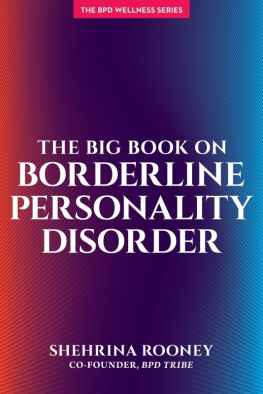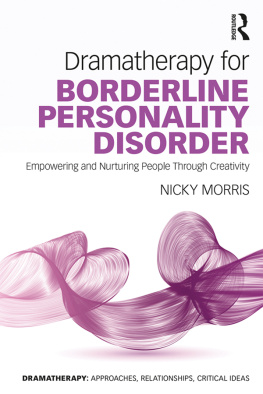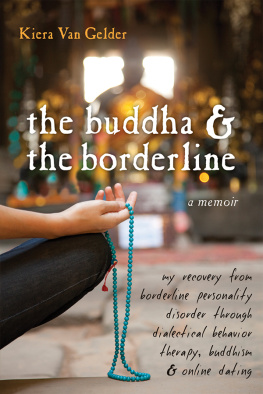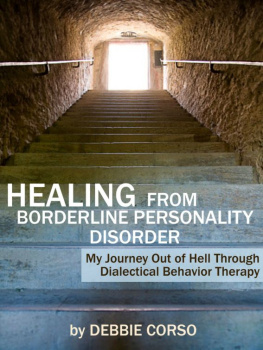
Borderline and Beyond, The Original
(Ebook Edition)
(c) Laura Paxton, June, 2013 ISBN
978-0-9675614-1-7
Carmel Heart Media
Eugene, Oregon
Visit http://www.carmelheart.com
This document may not be reproduced without written permission of the author, Laura Paxton. All Rights Reserved.

TABLE OF CONTENTS
2013
Preface
2013 Preface
I am very pleased to present Borderline and Beyond, restored to original condition.
The original Borderline and Beyond was written when I was a twenty-six year old girl who was struggling hard to cope with finding the will to live and the courage to live a different way. I had just left a three week stay at the state mental hospital in Georgia after a near-fatal suicide attempt. While I was there, I realized I was never going to have a better life until I learned how to take responsibility for my life and my recovery. The problem was that I wasnt sure how to do that. So, I started experimenting with different coping skills and taking notes about what worked and didnt work. I shared the method I used, as well as my results in the original edition of Borderline and Beyond.
I am restoring Borderline and Beyond to its original condition now as a woman in my mid-forties. Through my many life experiences, I have learned that my first work was the best. Im not sure why I found it lacking or revised it at all. Borderline and Beyond was very effective in helping me and many others regain both the desire to live and a new way to make that work for them. Any additions, such as those about self-esteem, spirituality or autism, seemed to detract from the purity of that original work. So, Ive learned to return to where I started.
Borderline and Beyond was written from a raw and vulnerable state. Writing the book was the only way I knew to restore a sense of hope and dignity to my life. In doing so, I spoke directly to the heart of many people deep in pain and struggling and offered them the essential early building blocks for their new lives in recovery. I hope my book will do so again.
My book has been revised repeatedly through the years. What began as a single volume with spiral binding in 1997 became a paperback book and workbook set in 2001 and was again changed in 2007 to add additional material.
Still, through all the changes in my life the book has reflected through the years, my best feedback has always been that people prefer the original edition, published for the first time in 1997.
The 2001 revision gained a new age influence. I had discovered through those types of practices how to gain a deeper sense of self-love, and so I wanted to share those insights. The additional material may have been helpful to others as well, but I am no longer comfortable with the content of that revision.
For one thing, that great self love wore off, as if Id never internalized it. I had come to live a life based on building up my ego through pursuit of pleasure, wealth, reward and status. Eventually, that selfish lifestyle became pretty empty.
I experienced quite a shock in my mid-thirties, when I received the diagnosis that not only did I not have borderline personality disorder, but that it is possible I may never have had it. Bipolar disorder as well as high functioning autism or aspergers syndrome was diagnosed instead, and two subsequent diagnostic assessments bore the same result. I felt I had let my readers down. I let my website go. I stopped offering training and counseling. During this time, I created the second revision of my book, in which I added more information about autism spectrum disorders. I had realized that the coping skills in my book helped me cope very well with whatever I had, so why not show the books usefulness with other conditions, such as autism?
Many people expressed disappointment with the second revision. The book lost the flow that had helped them before. The main focus appeared diluted. Yet, I became indifferent with the book, because I had resigned myself to feeling like a failure, because I had misunderstood my condition. However when I gave up interest in Borderline and Beyond, I failed to remember how many people wrote to me about how my book helped change their lives and helped them to live symptom free from borderline personality disorder. Those testimonials are still true, regardless of the change in my own diagnosis.
Also, the skills I learned as I wrote the original Borderline and Beyond worked to lift me up from a revolving door of hospitalization for suicidality and helped get me back to living a more fulfilling life. The program I wrote succeeded and can succeed for many people dedicated to getting better, regardless of diagnosis. Through coming to terms with myself and lifes experience, I once again developed the desire to share my original work with others, free of the extraneous material it once contained.
I hope you enjoy the restored
book!
Introduction
Introduction:
About Borderline Personality Disorder (BPD)
For years, those diagnosed with borderline personality disorder have felt as if they were just given the kiss of death. They have been told that they are suffering from a disorder which is difficult, if not impossible to treat. BPD is an illness that drives other people away from them just when they need those people most.
Persons suffering from BPD have also been told that they may never experience all of the emotions mature adults are able to experience, and that they may never experience the degrees of intimacy that other adults are capable of. Intimacy is that which the borderline individual both craves and fears most. It has even been postulated that as the illness appears to mellow or stabilize somewhat in middle age, some observers believe these people have achieved self-command and self-control by forgoing the intimacy that was both an imperative need and an intolerable burden for them in youth. (The Harvard Mental Health Letter, July 1994) What a sacrifice for these individuals to feel they have to make!
As Associate Clinical Professor of Psychiatry at the Harvard Medical School, Judith Lewis Herman, M.D., so astutely comments, the term borderline personality disorder is frequently used within the mental health professions as little more than a sophisticated insult.(Herman, 1992) Individuals suffering from borderline personality disorder have often been treated as psychiatric lepers, with treating professionals approaching them armored with rigid boundaries, negative expectations, and a poor prognosis. This does not need to be the case. Another alternative exists: to see the individual suffering from this disorder as courageous and full of creative potential.
About This Book: For the Clinician
Although this program is intended primarily for use by the borderline patient, this book is also designed to be read by mental health professionals and family members.
The text illuminates many clinical issues by treating this disorder in a new light. Clinical issues are presented in a readable format for the non-professional, and when psychological or psychiatric jargon is presented it is defined and made comprehensible for almost any reader.
Clinical issues are approached from many viewpoints, including: the object relations school, self-psychology, dialectical behavior therapy, psycho-dynamic theory and cognitive/behavioral perspectives. This eclectic format has been integrated into one very whole and practical perspective designed for maximum therapeutic benefit for the patient. The issues presented include: strengths inherent in the borderline condition, coping with developmental arrest, micro-psychotic episodes, suicidal action, self-mutilation, masochism, abandonment trauma, addictive behavior vs. borderline behavior, intensity and perception, use of magical thinking, out-of-control feelings and behavior, affective instability, self-damaging behavior, development of boundaries, the grieving process as it relates to borderlines, the borderline society, the importance of networking, methods used to modulate emotional intensity, relapse prevention, self-reliance, therapeutic alliance, improving therapeutic outcomes and development of a sense of identity. Throughout it all, emphasis is placed on techniques proven to work and innovations arise in the text that stem from these proven techniques.
Next page










